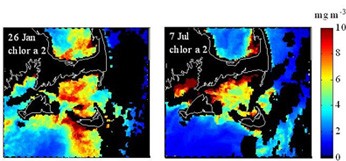Physical Forcing and Seasonal Variations in Phytoplankton in the Coastal Ocean
The overall objective of this project is to understand the processes controlling the seasonal variability of phytoplankton biomass over the inner shelf off the northeast coast of the United States.
Coastal ocean ecosystems are highly productive and play important roles in the regional and global cycling of carbon and other elements but, especially for the inner shelf, the combination of physical and biological processes that regulate them are not well understood. Past studies have shown dramatic seasonal variability in phytoplankton biomass on the northeast US shelf with low levels between the spring and fall equinoxes, and high levels with high variability between the fall and spring equinoxes. Information on the inner shelf is sparse, but suggests pronounced winter blooms. This study, funded by the National Aeronautics and Space Administration’s Office of Earth Science, combines analysis of satellite imagery, Regional Ocean Model System (ROMS) numerical simulations, and long-term, in-situ measurements of biological, physical, and chemical variables at the Martha’s Vineyard Coastal Observatory (MVCO).
Investigators from WHOI plan to document changes in phytoplankton biomass on the inner continental shelf over a range of space and time scales. In conjunction with investigators from Rutgers University, measurements and models will be used to characterize vertical mixing and cross-isobath transport processes. This interdisciplinary approach should help to improve understanding of winter and autumn phytoplankton blooms over the inner shelf with an emphasis on their relationship to physical processes that regulate light and nutrient availability. These results will significantly advance knowledge of how physical, chemical, and ecological factors interact to regulate variability in phytoplankton biomass in coastal regions. This knowledge is critical for assessment of climate change and anthropogenic effects on coastal ecosystems.

(Image courtesy of Heidi Sosik)